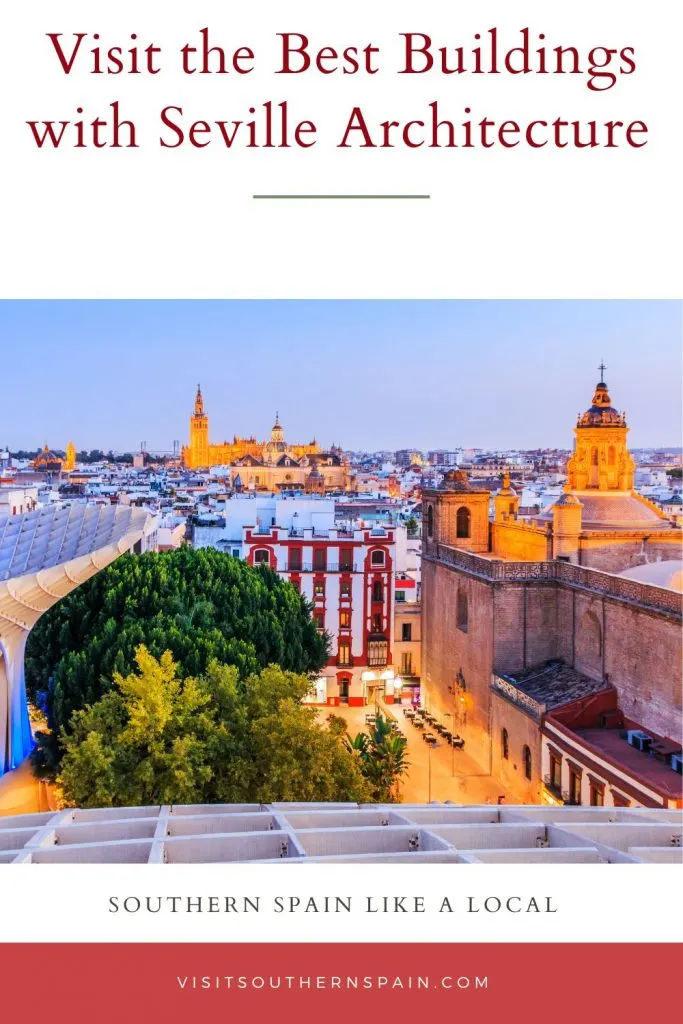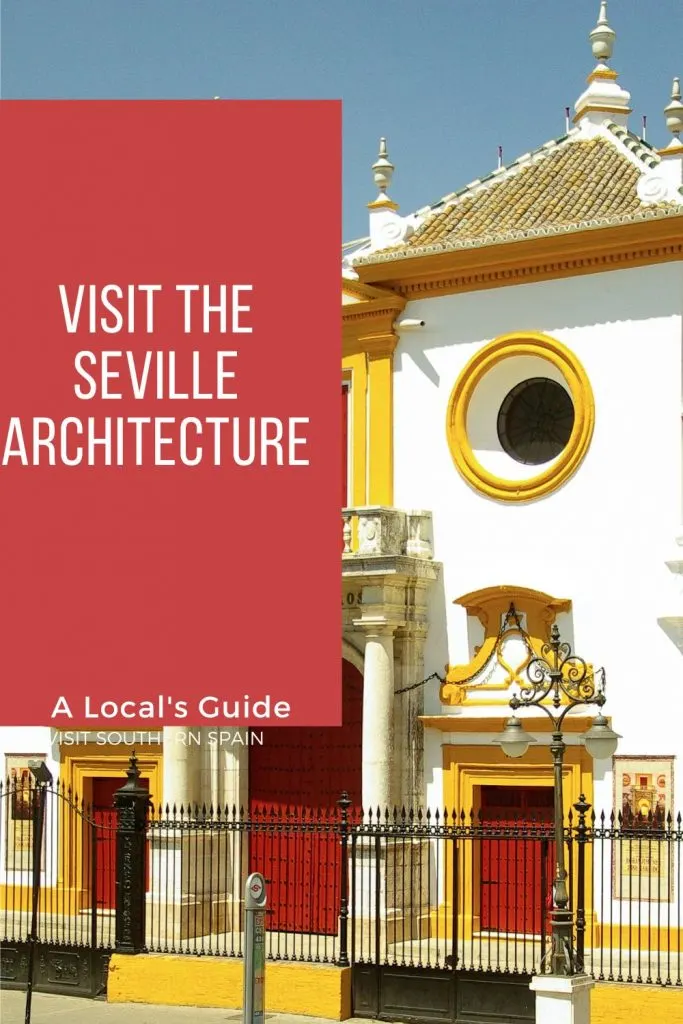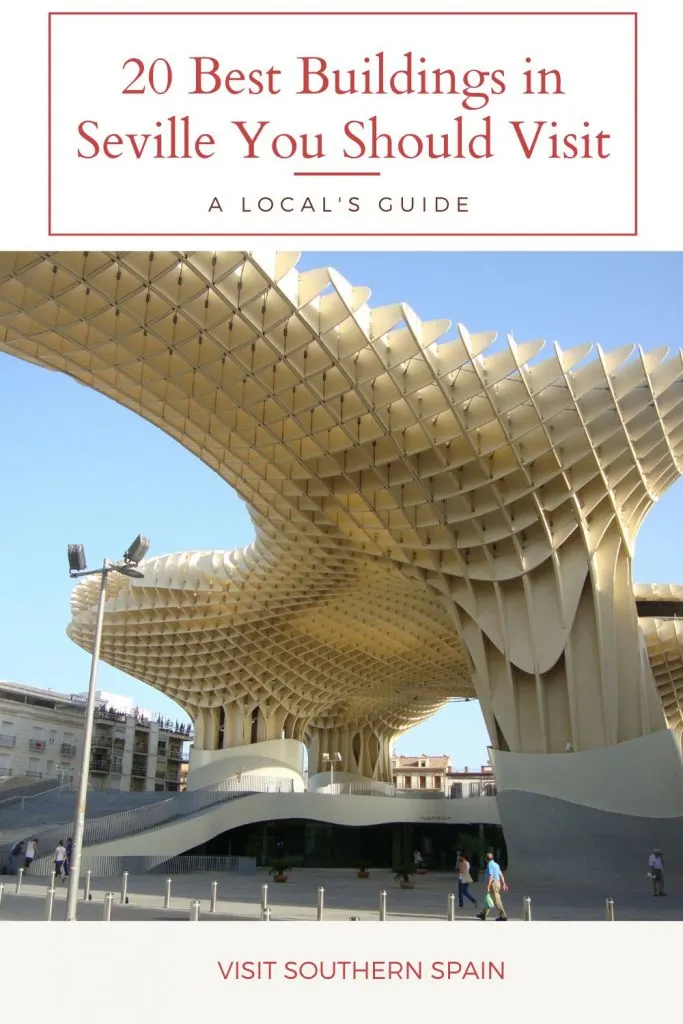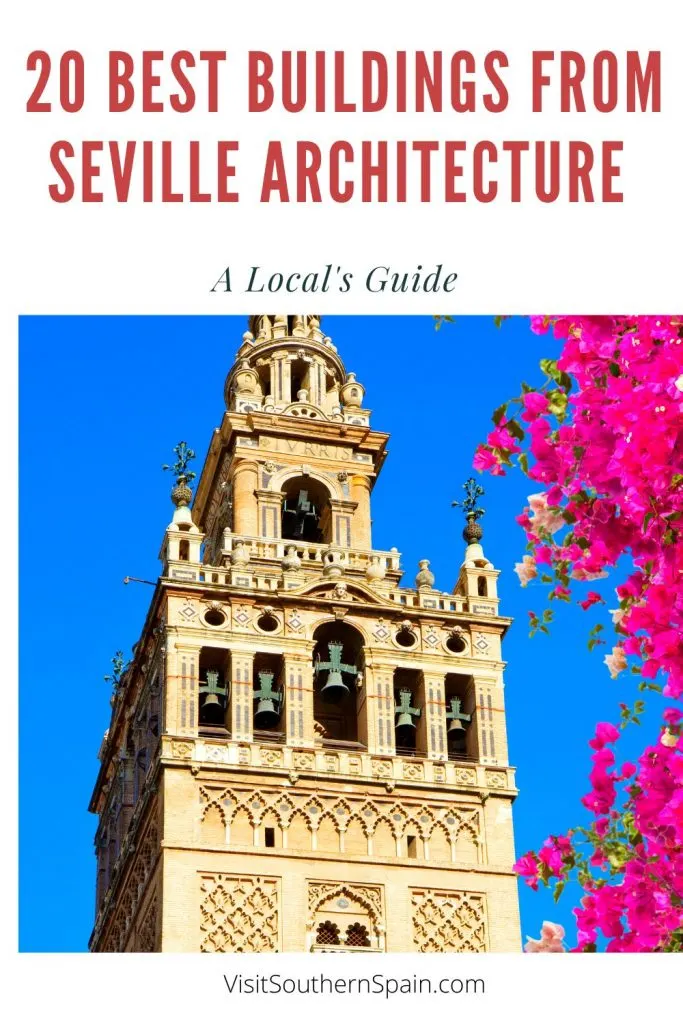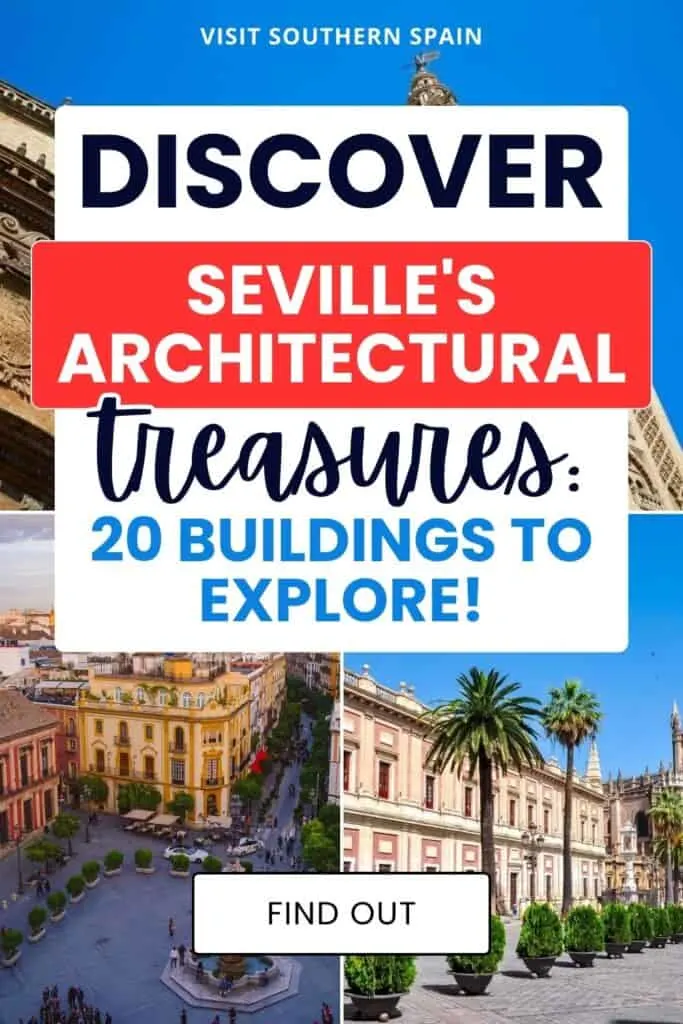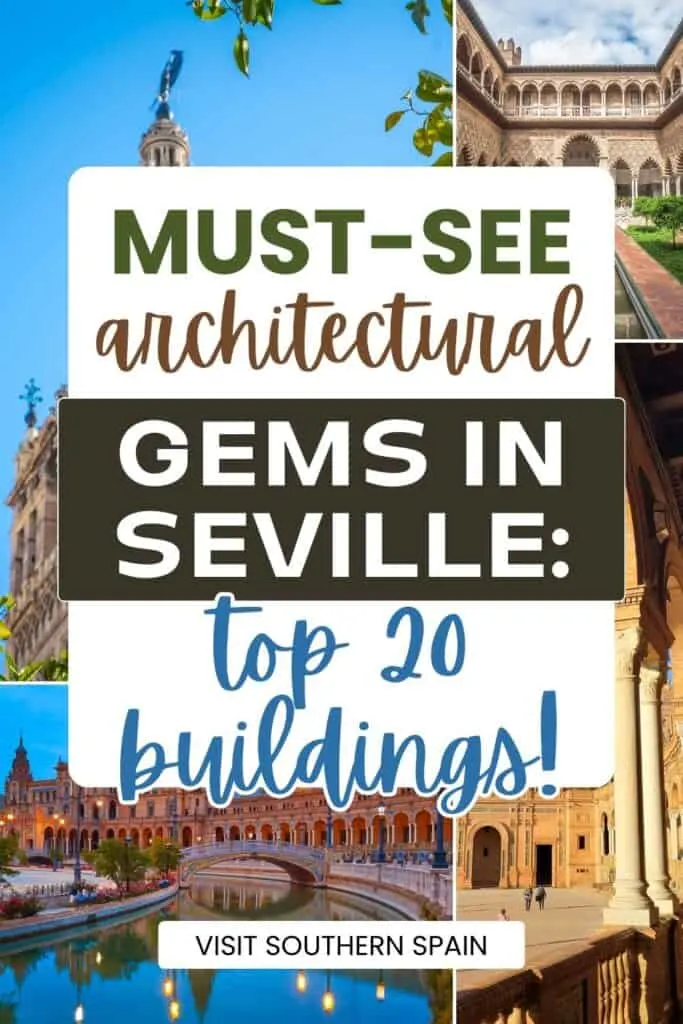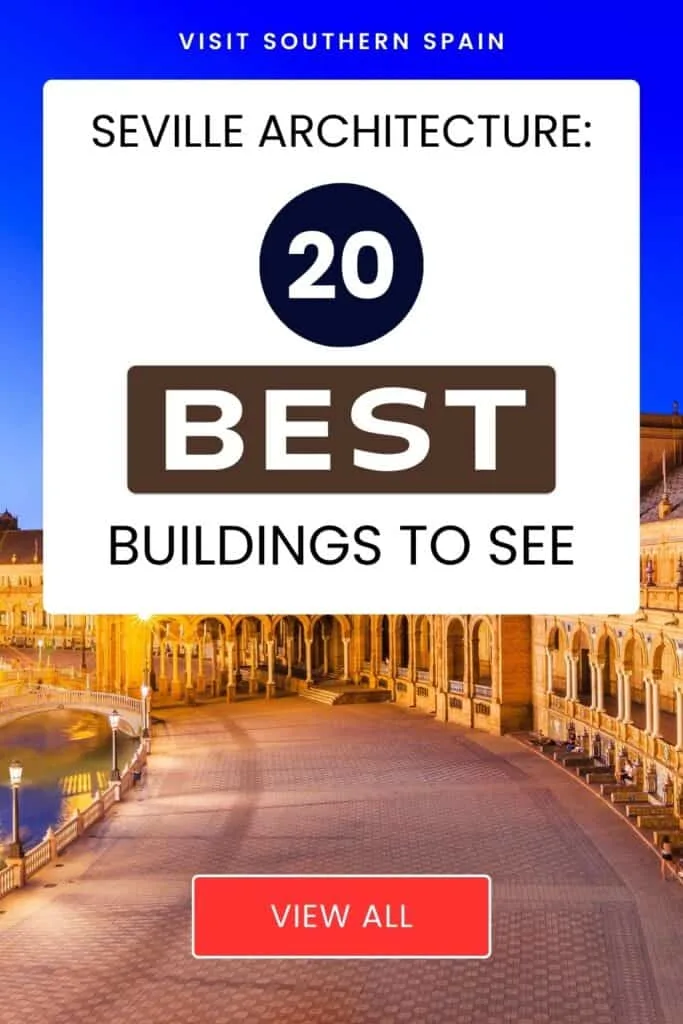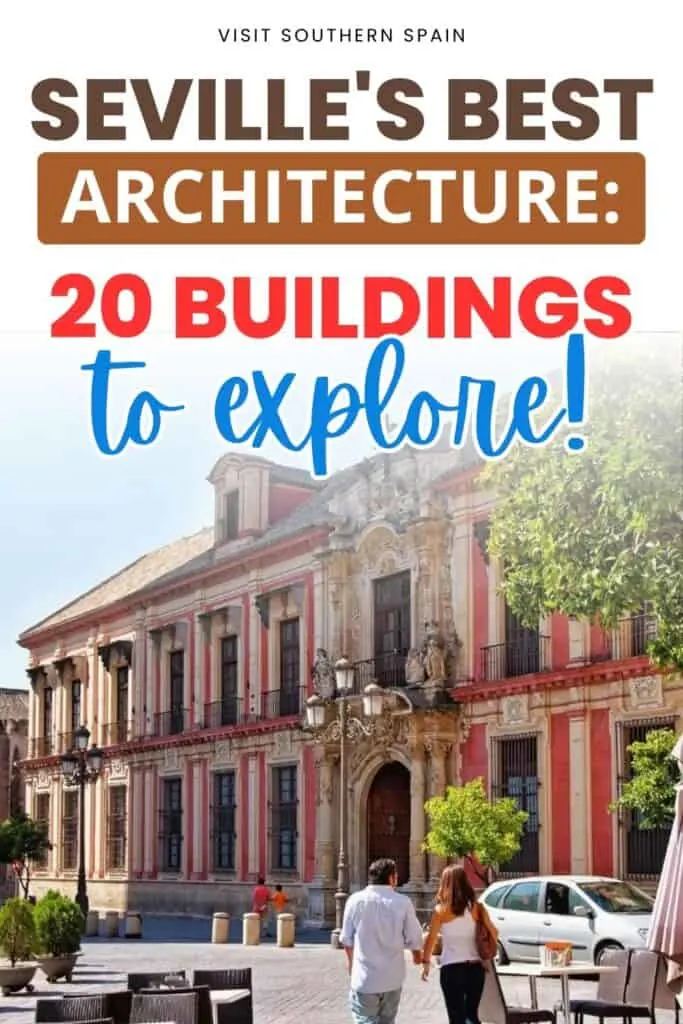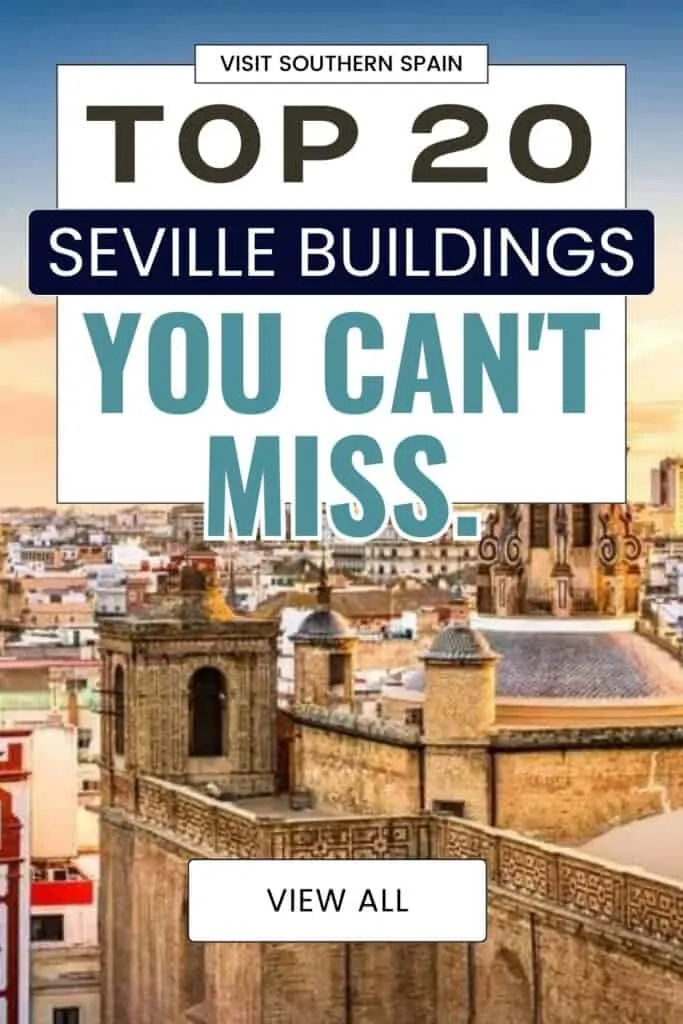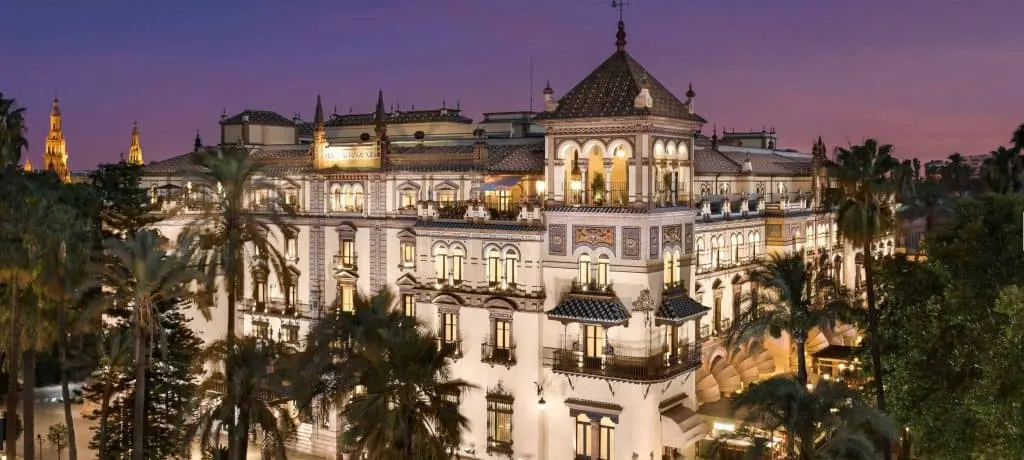A guide to Seville Architecture and the best building you should visit
From inspiring baroque architecture to luxurious palaces, Seville is saturated with an abundance of contemporary and ancient landmarks.
Brimming with history, Seville has been the home of numerous empires and cultures throughout the centuries.
But with so much Seville architecture to feast your eyes on, it can be a challenge to figure out the best buildings in Seville to visit in a short time frame.

You, dear reader, support this blog. If you purchase through a link, we earn a small commission. As an Amazon Affiliate, we earn from qualifying purchases.
This post will provide a comprehensive guide to the best buildings to see in Seville and explain why they are so emblematic of Spanish architecture.
OVERVIEW: Seville Architecture – The Best Buildings to See
● Royal Alcázar Palace
● Seville Cathedral
● Metropol Parasol
● Hotel Alfonso XIII
● Giralda Bell Tower
● Puente de Triana
Useful Travel Information About Seville
✈ Book cheap flights to Seville with Skyscanner
⚘ Avoid tourist traps and get the customizable “Andalucia Like a Local” itinerary. – Get it here
✔ Book tours in Seville with GetYourGuide
➳ Find the best hotels in Seville with Trivago
❖ Rent a car at the best rates with DiscoverCars
✎ Never leave without travel insurance! I get mine at SafetyWing. It is easy to set up, cheap and reliable.
$ Withdraw money without hidden fees and avoid exchange charges with TransferWise (A free Mastercard debit card to spend money abroad)
Things to know about Seville Architecture
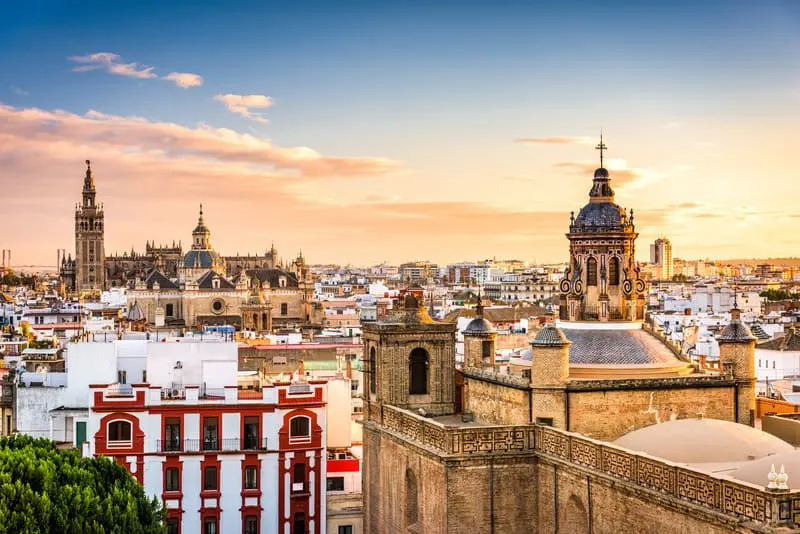
Seville, the Andalusian capital in southern Spain, has housed many famous designers and influential architects over the centuries.
Seville architecture has an intriguing past, and those keen to find it often enjoy significant remnants of its earlier civilizations.
Individually, each society left its influence over the years, leaving a unique stamp contributing to its architectural wonder.
Seville flourished remarkably under Roman rule, and the various unique monuments and astounding aqueducts they put in place are a living testimony to their great empire.
Who would have thought that one didn’t have to travel to Rome to glimpse the architecture with which Julius Caesar is said to have influenced?
Additionally, the Jews, Moors, and Christians shaped the essence of Spanish architecture, and the city of Seville is where you can personally witness this melting pot of influence.
In modern times, Seville architecture has also become famous due to its use as authentic scenery for blockbuster movies, including Star Wars and Game of Thrones.
You’ll soon discover a lot of impressive architecture in Seville to fit into your itinerary. See some of our best selections below to help you to prioritize the ones you want to visit.
Are you just for one day in Seville? No worries as you can spend one day here and still see the best parts of Seville.
Seville Architecture – The Best Buildings you Should Visit
1. Royal Alcázar Palace
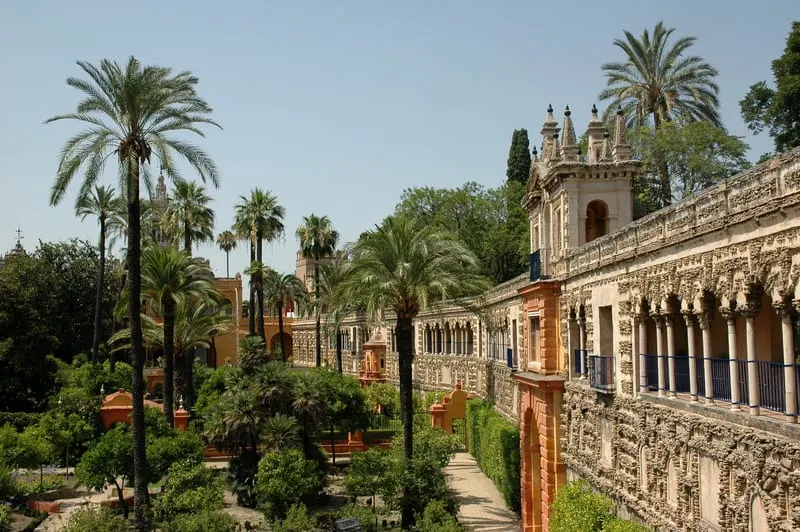
The Royal Alcázar Palace is an exquisite building built in 913 CE and is one of the finest examples of Moorish architecture with a long and exciting history.
It was initially built as a fortress by the Moorish rulers of Seville. Later, it expanded and became a royal palace.
In the 19th century, it was used as a military academy. Today, the palace is a museum open to the public.
With mesmerizing royal chambers and halls, the Royal Alcázar Palace is an attraction not to rush but to reflect on.
This palace has such a wonder to behold that you will likely not stop taking photos during your visit!
The Ambassadors Hall is one such room. Here you’ll have the pleasure of viewing the magnificent throne room created during the 11th century.
If it were not stunning enough back then, one Spanish monarch decided it should become the centerpiece of his Royal suite.
Renovated in the 14th century, he included more decorative plastered arches between rectangular frames with every fascinating detail individually painted gold.
The walls were covered with tiled panels, each with its own intrinsic design also coated in gold.
One could only begin to imagine how many hours were painstakingly involved in creating such an architectural masterpiece.
Opening times:
The Palace is open Monday-Saturday from 9:30 am- 5:00 pm and Sunday from 9:30 am- 7:00 pm. Admission is €14.5 for adults and €1 for children under 13.
You’ll probably appreciate at least a 3-hour slot in your itinerary for the Royal Alcázar Palace.
2. Seville Cathedral
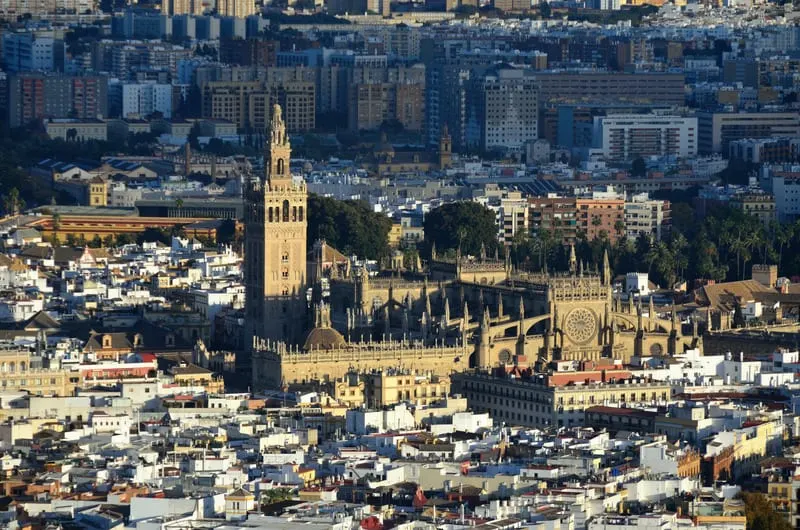
Seville Cathedral is a captivating landmark located in the center of Seville. Being one of the largest churches in the world, it is a must-see from that standpoint, yet its architecture is a work of art.
The impressive cathedral was built on the site of a Moorish mosque, which was taken from the Moors in 1248.
The mosque was used as a cathedral until it was destroyed in the 13th century. Construction of the current cathedral began in 1403 and was finally completed in 1507.
The Seville Cathedral is a five-aisled cruciform church with chapels and is 417 feet long (127 meters), 272 feet wide (83 meters), and 141 feet (43 meters high).
The interior is even more breathtaking than the exterior, with a forest of crafted columns and contains the world’s largest altar.
The cathedral was built to house the remains of Christopher Columbus and is, therefore, a top-rated tourist destination.
The building is also home to the Tomb of Ferdinand III, Seville’s patron saint, and the Chapel of the Holy Chalice, which is said to house the cup of Christ.
With a visitor footfall of thousands every month, without a doubt, this is one of the most famous places in Spain.
The best time to visit the cathedral is early morning when it is less crowded, or visit Seville in Winter for a less-crowded tour.
Opening times:
Monday to Saturday, 10:45 am to 5:00 pm, and on Sundays and holidays, from 2:30 pm to 6:00 pm.
If you plan to visit Seville, the Seville Cathedral should be on your list of things to see. It is an incredible example of Gothic architecture and is sure to leave you in awe.
3. Giralda Bell Tower
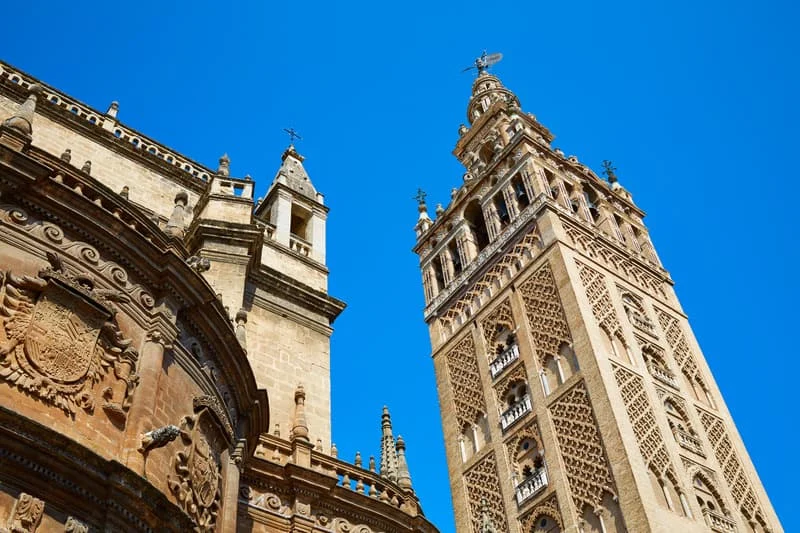
When mapping out Seville, be sure to locate the Giralda Bell Tower. This incredible building is one of the city’s best examples of Moorish architecture.
Yet a closer look reveals even older segments. The tower was rebuilt in the 12th century and served as a minaret for the nearby mosque.
Today, it is one of the most popular Seville tourist attractions.
Giralda Bell Tower is one monument that makes up Seville’s extensive heritage and is undoubtedly one of the most majestic buildings in Spain to see.
The tower is 342 feet (104 meters) tall and offers breathtaking views of the city. The tower comprises several flawlessly merged sections, echoing the cultural fusion of Seville’s past and present.
The stone from the Moorish era is easily identified, and the Romans left their mark when they located Seville (then known as Hispalis).
Evidence of this can be observed if you look carefully at various bricks containing Latin dates at the tower’s base.
Insider Tip; if you want to avoid the crowds, visit the Giralda Bell Tower early in the morning or late at night.
Opening times:
The Giralda Bell Tower is open every Monday – Saturday from 9:00 am to 5:00 pm and Sundays from 2:30 pm to 6:00 pm.
4. Costurero de la Reina
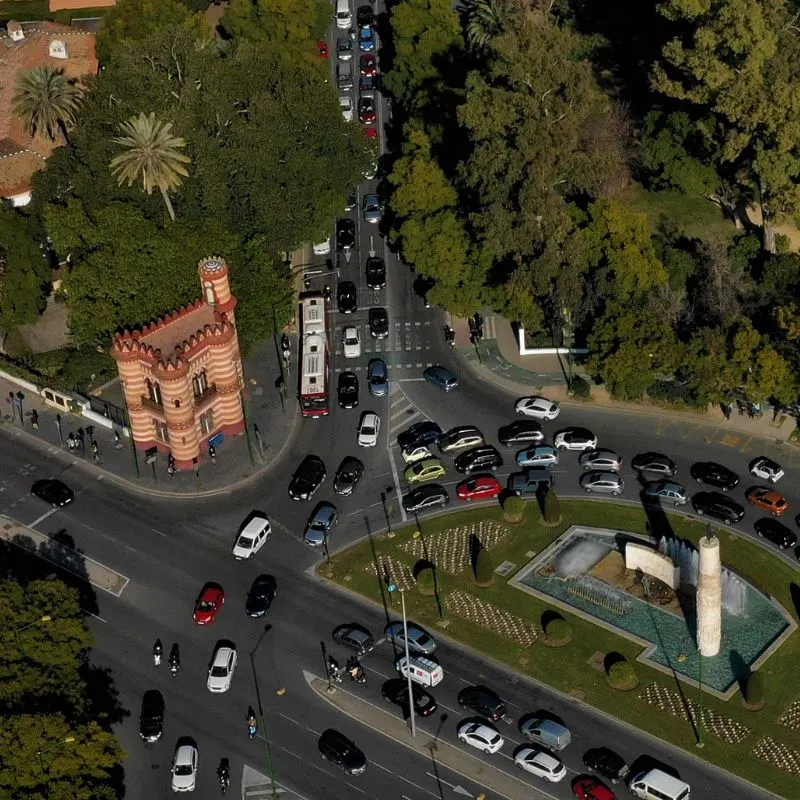
The Costurero de la Reina’s unique architecture and rich history make it one of the city’s most thrilling places in Sevilla city.
It was built in the 19th century in the Palace of San Telmo gardens and designed by the local architect Juan de Dios de León y Corona.
A gorgeous building in the form of a small chateau with circular turrets capped with an abundance of petite peaks.
The building is a unique blend of Moorish and Gothic styles and boasts renaissance elements.
The beautiful facade embroiders meticulous carvings and features a lavish arched doorway. Inside, the building is just as breathtaking with its decorated roofs, mosaic foundations, and stained glass windows.
The exterior is made of bicolored bricks and has a unique octagonal shape. It is decorated with thousands of terracotta tiles and has a large, central skylight.
The Costurero de la Reina was initially used as a deluxe workshop for the queen’s personal seamstress.
It is now an attractive museum that houses a collection of clothing and accessories from the 18th and 19th centuries.
Insider tip; be sure to visit the Costurero de la Reina during the daylight hours so you can see the beautiful tile artistry on the exterior of the building.
Opening times:
The museum is open every day from 09:30 am to 10:30 pm.
Upon visiting, you’ll observe that the details on the turrets and windows are stunning, and it really was an imposing ‘queen’s sewing room in its day. Undoubtedly worth a look!
5. General Archive of the Indies
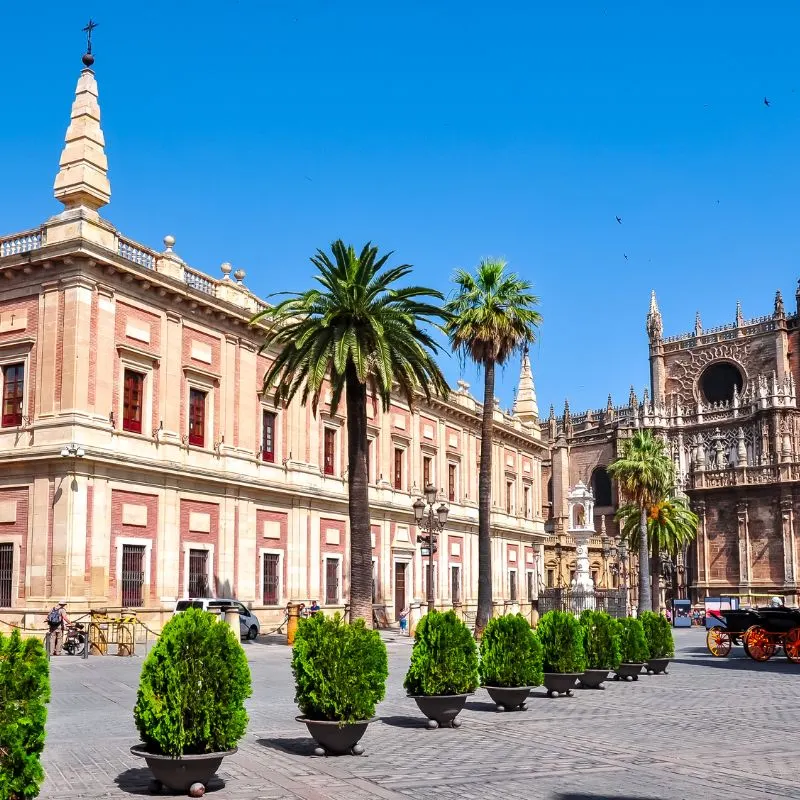
The General Archive of the Indies is one of Seville’s most important historical buildings. It was built in the 16th century to house the administrative records of the Spanish Empire.
Today, it is a UNESCO World Heritage Site and one of Seville’s most popular tourist attractions.
The General Archive of the Indies is a must-see for anyone interested in chronological architecture.
Built during the reign of Phillip II, the exterior of the building is impressive, with ornate decoration and intricate details.
The interior is just as remarkable, with a beautiful central courtyard and a wealth of historical documents on display. The General Archive of the Indies is a must-see if you’re visiting Seville.
Insider tip: buy your tickets in advance online to avoid the long queues!
Opening times:
The building is open to the public from Tuesday – Saturday: from 9:30 am to 4:45 pm, and Sundays: from 10:00 am to 1:45 pm.
6. Puente de Triana
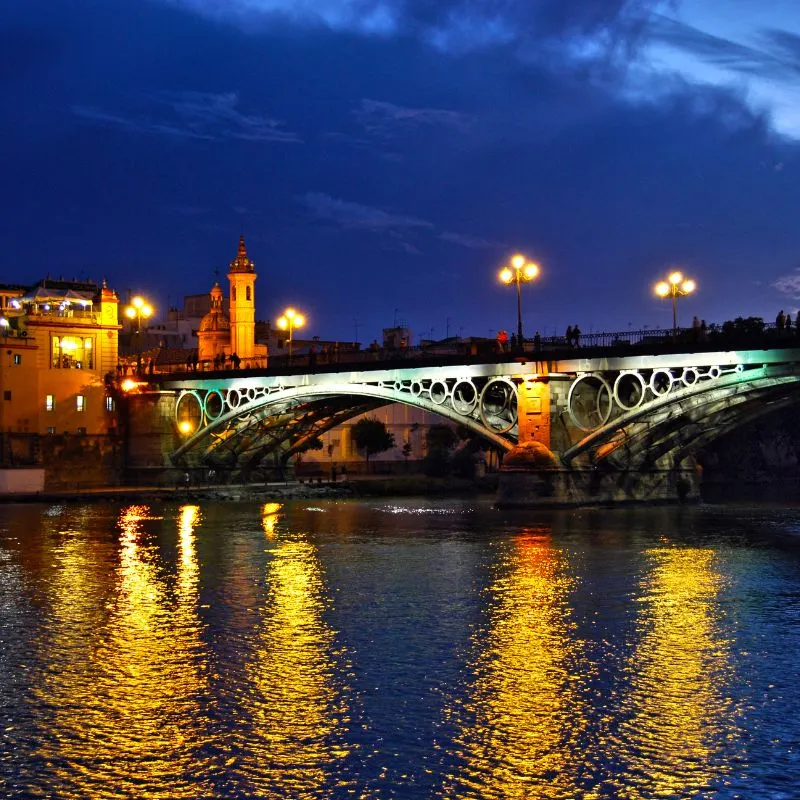
One of the most recognizable landmarks you won’t forget from Seville is the Puente de Triana.
This bridge spans the breadth of the Guadalquivir river and was built in 1852. With its exquisite three arches and ornamental tile work, Puente de Triana is a masterpiece in its own right.
Engineers Ferdinand Bernadet and Gustave Steinacher gained inspiration for their marvelous Seville architecture from the Pont du Carrousel, which onetime towered the river Seine in Paris.
French engineer Polonceau is best known for this patented method of bridge construction, which features wooden arches encased by cast iron plates.
The bridge is an impressive 154.5 meters long (505 feet), almost 16 meters wide (52 feet), and 12 meters high (39 feet) from its base.
History reveals that during the Roman era, the authorities rejected the notion of joining the sections of Seville banks by constructing a sturdy bridge.
Later the Arabs opted for a non-permanent bridge, known simply as the Bridge of the Boats.
Thirteen wooden boats chained together and banded with planks provided a crossing for locals and cattle alike until work commenced in 1845 on the Puente de Triana.
If you are visiting Seville, the Puente de Triana is a must-see. The Mirador de Triana is a restaurant where you can dine while gazing at this delightful bridge.
Opening times:
12–3 pm and 8 pm – 12 am daily.
Here are a few insider tips to make the most of your visit:
The best time to visit the bridge is in the evening when the sun sets. This is when the bridge is well-lit and becomes even more spectacular. If you are interested in learning more about the bridge’s history, guided tours are available. The tours run almost every Sunday at 11 am and last 45 minutes. There is a small market on the Triana side of the bridge, where you can buy the best Spanish souvenirs and local handcrafts. If you want a great photo of the bridge, head to the Mirador de Triana on Calle Betis. This is a viewing platform with panoramic views of the bridge and the river.
7. Archbishop’s Palace
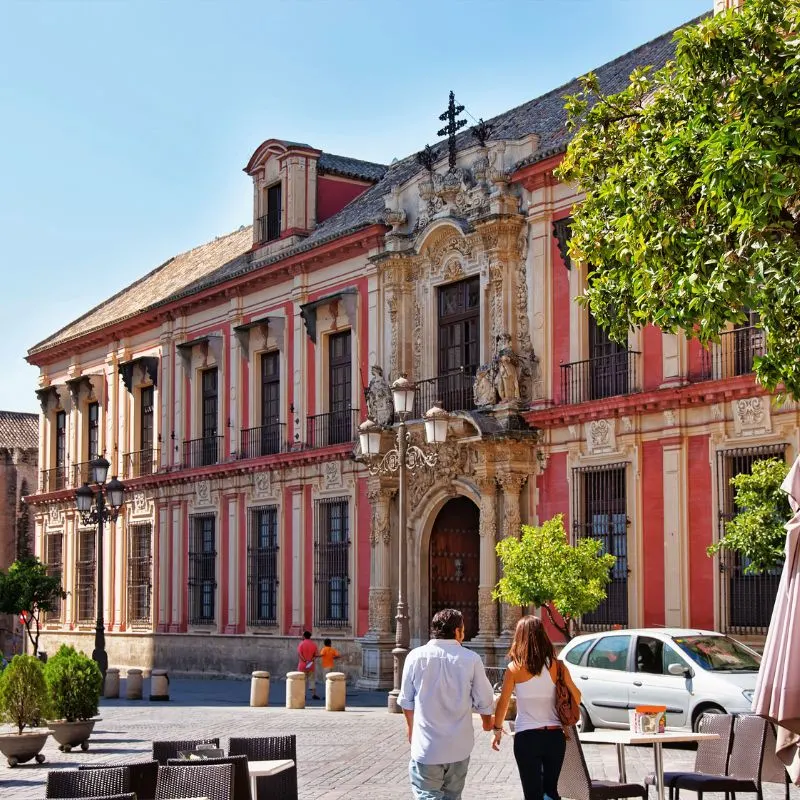
The Archbishop’s Palace is adjacent to the famous Cathedral and Giralda tower. One of the city’s most exhilarating and most beautiful buildings, it was built in the 18th century and is a classic example of Baroque architecture.
With its red facade, cream columns, petite iron canopies, and extensive balconies, it served as the residence of archbishops and numerous noblemen and military figures over the years.
The building was extended over the decades and now occupies a whole block.
The central entrance was designed in the 18th century and has fascinating shields on display.
The doorway is adorned with vegetal motifs designed by Lorenzo Fernandez de Figueroa and Diego Antonio Diaz, who meticulously embellished each pillar, arch, and coat of arms.
Opening times:
The Palace is open to the public from Monday to Saturday, 10:00 am to 6:00 pm, and Sundays from 11:00 am to 6:00 pm. Admission is €5 for adults and €1 for children.
Insider tip:
Visit the Palace during the day to see all the exterior details. The Palace is beautiful at night, but you won’t be able to see as many delightful details.
8. Metropol Parasol (“Las Setas”)
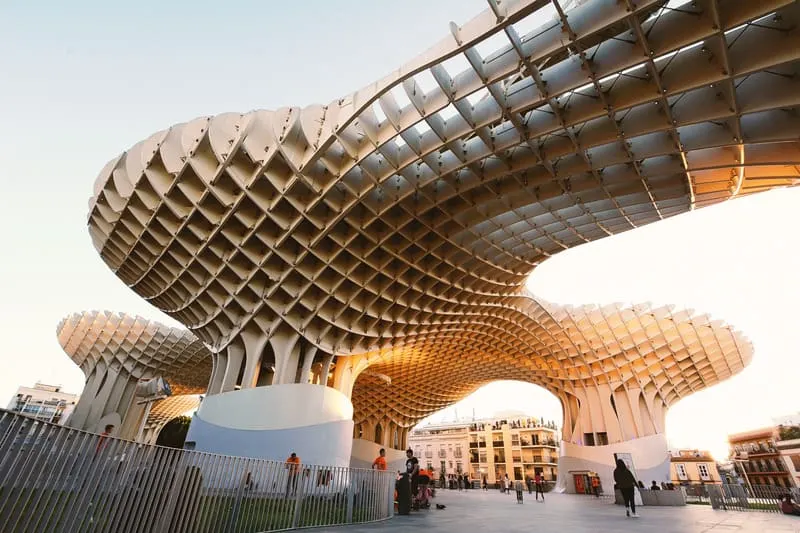
If you’re looking for a unique architectural experience, look no further than Metropol Parasol in Seville, Spain.
This incredible structure, also known as “Las Setas,” is one of the most intriguing buildings in the city.
Metropol Parasol was designed by the acclaimed architect Jürgen Mayer-Hermann and completed in 2011.
The structure contains six massive parasols, which are eye-catching and provide shade. If you’re in Seville (a.k.a frying pan) in the summer, you’ll be glad about that part!
It’s interesting enough looking upwards from the ground, but for just over a Euro, you can ride an elevator to the walkway on top for amazing city views.
What makes Metropol Parasol so unique is its unusual design. The parasols are made of carved wood and steel and resemble enormous mushrooms.
Both visually striking and functional, it’s a genuinely remarkable piece of architecture you won’t find anywhere else in the world. Metropol Parasol is characteristic of Spanish modern architecture at its best.
Insider tip:
Go early in the morning or later in the evening to avoid the heat and crowds. If you decide not to pay a Euro for the elevator, some stairs also take you to the ‘gods’ to enjoy the world from up high. Metropol Parasol is among the many free things to do in Seville.
Opening times:
Sunday to Thursday, from 9:30 am to 11:00 pm, and from Friday to Saturday – from 9:30 am till 11:30 pm.
9. Church of Divine Salvador
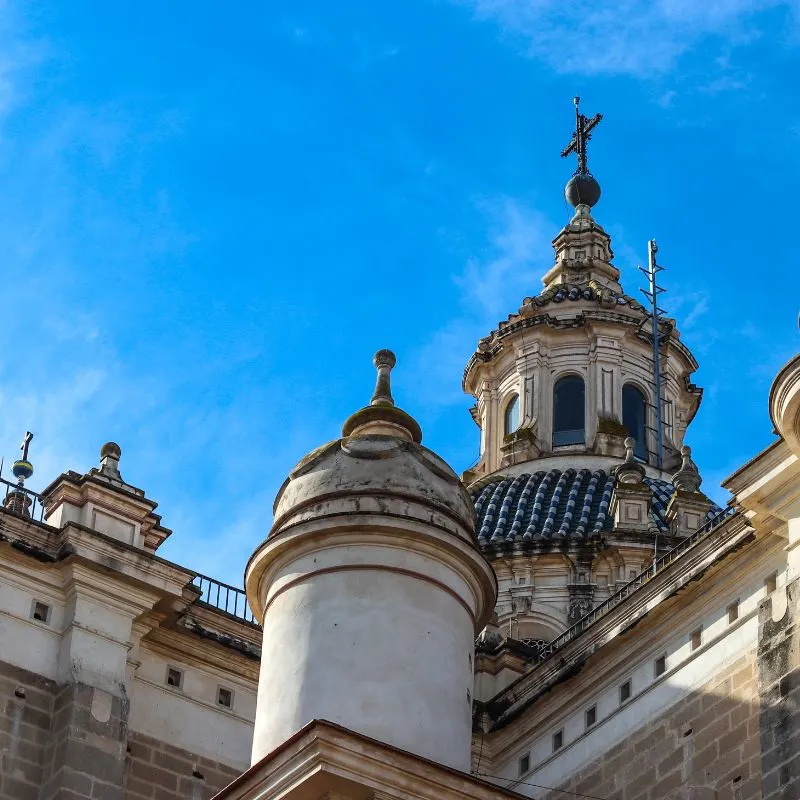
This beautifully decorated church is one of Seville’s most popular tourist attractions. It was built in the 9th century and is considered one of Seville’s most monumental and representative creations of the Baroque style.
Past the extravagant facade lies an extensive temple with a remarkably pronounced 18th-century Baroque organ and diverse altarpieces with great artistic value.
The old Mosque ruins are still identifiable outside the beautiful Patio de Los Naranjos courtyard.
Here are some tips to make the most of your experience:
The best time to visit is early morning when the light is softer and the church is less crowded. If you want to take photos, use a tripod as the lighting inside can be pretty dim. There is a small church museum that is worth checking out. Be sure to dress modestly if you plan on visiting, as this is a place of worship.
Opening times:
The Church of Divine Salvador is open Monday-Saturday from 11:00 am to 5:30 pm and Sundays and holidays from 3:00 pm to 7:00 pm. The admission fee is €5.00 for adults and free for children under 12.
10. The Bullring
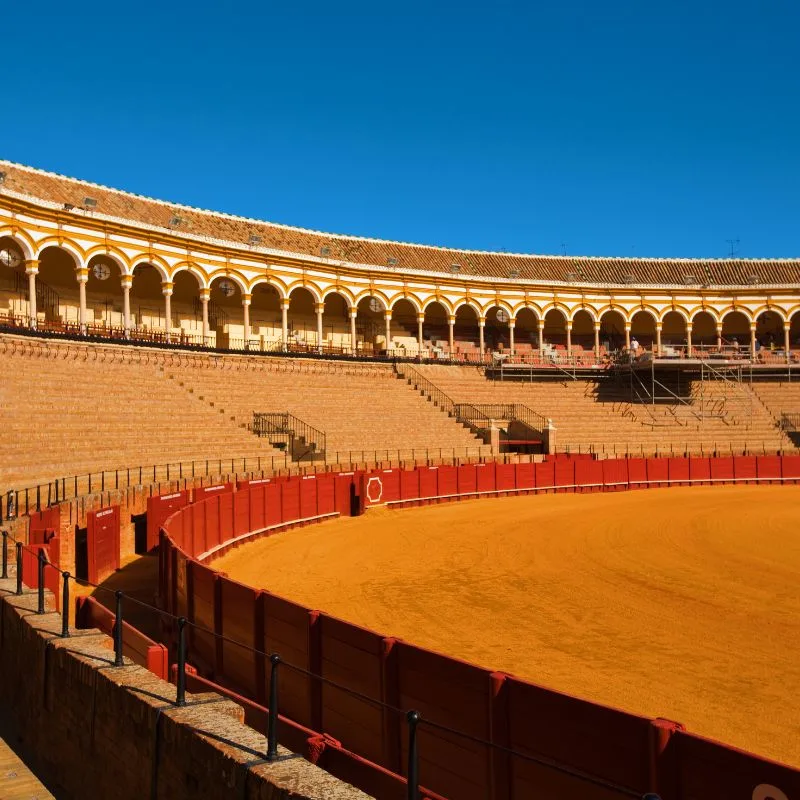
The Bullring in Seville should be on your ‘to-see’ list if you’re interested in striking architecture.
This brightly decorated building dates back to the 18th century and is one of Seville’s best examples of Baroque architecture.
Inside the building is an ornate fence and pillars adorned with intricate details and statues making it an imposing sight.
The main arena is enormous and accommodates around 12-14,000 people, making it one of the largest bullrings in Spain.
Elaborate arches surround the ring itself, with the most detailed section being the Prince’s box, dedicated to Spanish Royalty.
Beneath the Royal box is the ‘Prince’s gate’ via which triumphant bullfighters exit the ring.
The main entrance is the Puerta del Príncipe (Prince’s Gate), which is decorated with two gigantic iron gates.
It was designed by Pedro Roldán and is one of the most photographed pieces of architecture in Seville.
Here are a few inside tips for visiting the Bullring:
If you want to avoid crowds, visit during the week instead of on weekends. The best time to visit is in the morning when the light is better for photography.
If you want to learn more about the history of bullfighting, there is a small museum inside the Bullring.
The Bullring is open to visitors all year round, but bullfights only take place from April to October so if you’re after things to do in Seville in October, here’s the right place.
The best way to get to the Bullring is by taking the metro (Line 1) to the Prado de San Sebastian station.
11. Casa de Pilatos
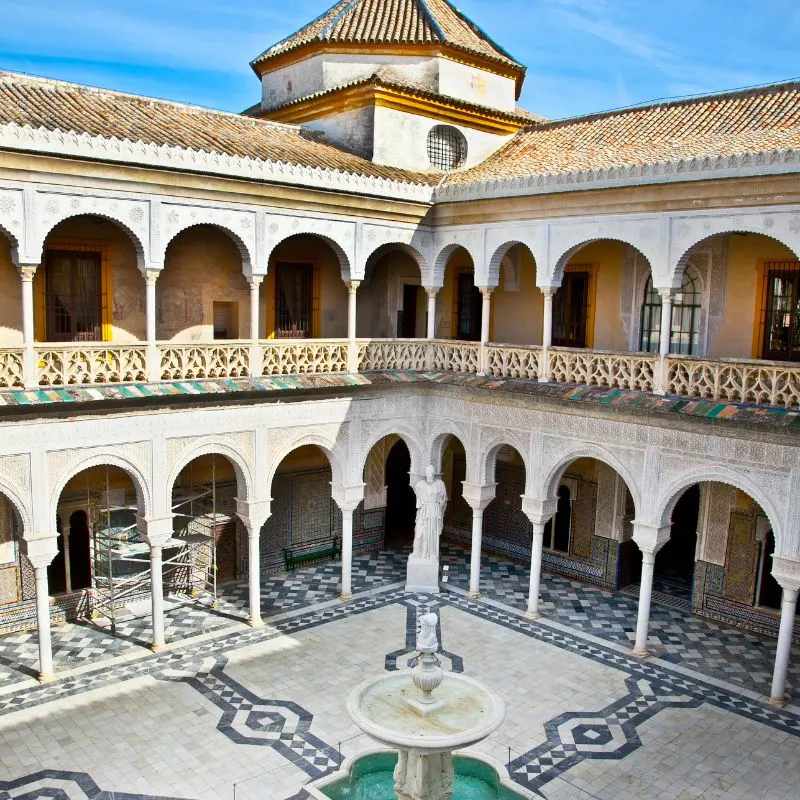
Casa de Pilatos is a beautiful example of Renaissance architecture. This gorgeous palace is a must-see for any visitor to the city, as it is one of the finest examples of Seville architecture at its best. It now serves as the grand quarters of the Dukes of Medinaceli.
Casa de Pilatos was built in the 16th century by order of Pedro González de Mendoza, the first Marquess of Cadiz.
The Palace has a stunning central courtyard, surrounded by a colonnade and decorated with a dominant fountain and sculptures.
The interior of the Palace features sumptuous furnishings and works of art.
Visitors will relish the structure of the magnificent staircase, the grand salon, and the beautifully tiled floors.
Opening times:
The timings for visiting Casa de Pilatos are 9:00 to 7:00 pm during summers and 9:00 am to 6:00 pm during winters.
The entry fee is €10 for adults and €2 for children. The best time to visit the Palace is in the m morning, as it gets very crowded in the afternoon.
Insider tip:
If you happen to be during the Easter week in Seville, you can see the beautiful processions that pass through the courtyard of the Palace.
12. Maria Louisa Park
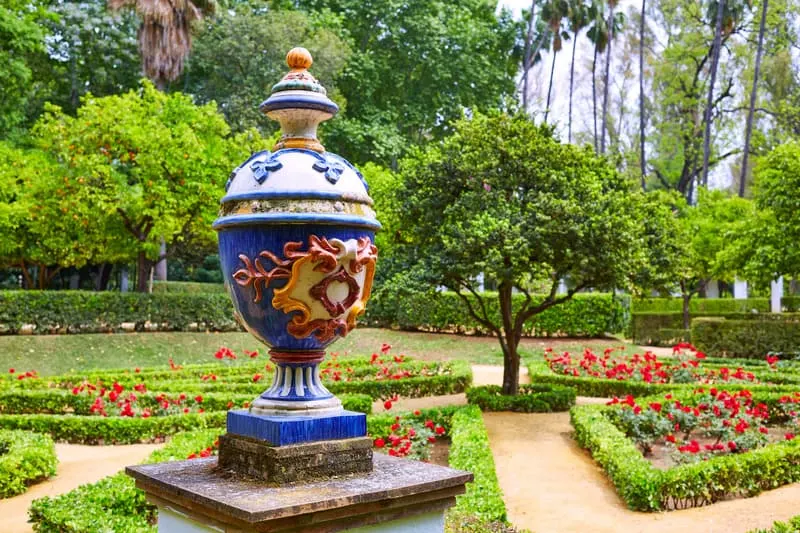
With hundreds of exotic trees & ambient sound of the working sculptured fountains, it is easy to imagine that you are in paradise.
Once a gift for king Ferdinand 7th’s daughter, this enormous park is undoubtedly one of the finest parks in Europe.
In 1915 the park was extended to include even more land adjacent to the pretty Plaza de España.
Various marble monuments with literary and cultural references were designed, including the Monument to Bécquer Monument.
The statue is dedicated to the poet Gustavo Adolfo Bécquer and has three female figures sitting on a bench dreaming of his poetry & persecuted by Cupid.
Encircled by the small Glorieta garden, this romantic beauty spot is popular for couples and families.
The best way to get to Maria Louisa Park is by taking the bus or metro to the Prado de San Sebastian station. From there, it is a short walk to the park’s main entrance, the Puerta del Príncipe
Opening times:
The park’s opening hours are from 8 am to 8 pm in the summer and from 8 am to 6 pm in the winter.
Insider tip:
The park gets busy, so be sure to visit earlier in the morning or evening to avoid the crowds.
Also, if you are visiting Seville during Halloween, the park hosts one of the best southern Spain Halloween traditions, which you cannot miss.
13. The Pre-Roman City of Italica
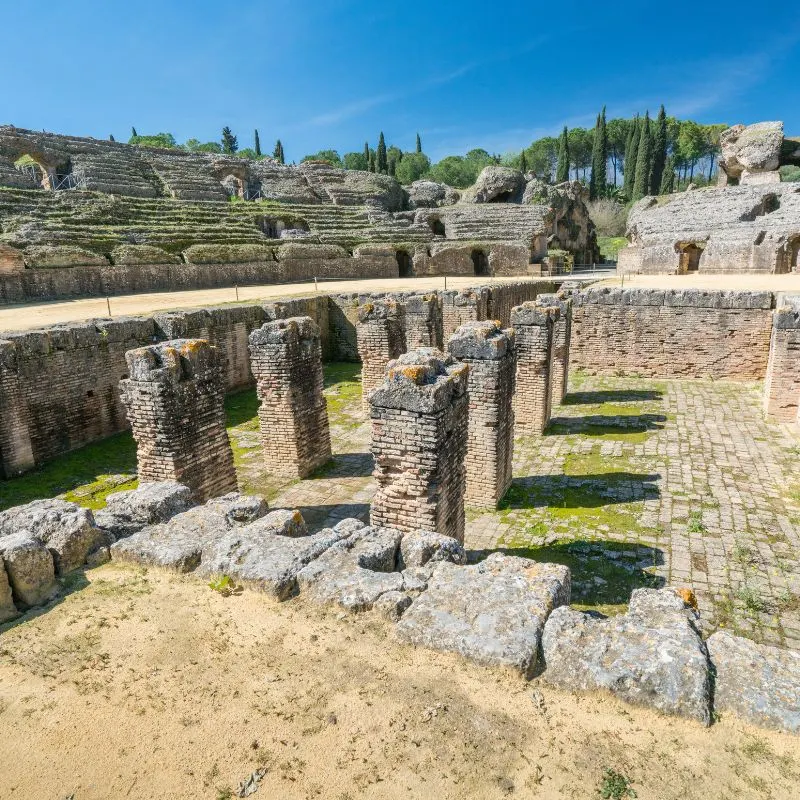
The Pre-Roman city of Italica, located in present-day Seville, was founded in 206 BCE by Scipio Africanus.
It quickly rose to become one of the most important cities in the Roman Empire, known for its refined architecture and marble sculptures.
At its peak, Italica was home to such famous figures as the emperors Trajan and Hadrian.
Today, Italica is a UNESCO World Heritage Site and a must-visit for anyone interested in Roman history and architecture.
With its still identifiable luxurious villas and city streets, it’s obvious why UNESCO has considered this famous building in Spain to be of ‘outstanding value to humanity.
Some of the most notable buildings in Italica include the Amphitheatre, which could seat up to 25,000 spectators; the House of Trajan, a luxurious private residence with stunning mosaics; and the Temple of Diana, an elegant temple dedicated to the Roman goddess of the hunt.
All these fascinating buildings in Seville cover an area of over 0.77 square miles (2 square kilometers).
Opening times:
The site is open to the public from 9 am to 5 pm, with extended hours in the summer. Admission is free for EU citizens and 1.5 Euros for non-EU citizens.
Insider tip:
To really appreciate the beauty of Italica, take a guided tour with an expert who can provide context and explanation for the different buildings and artifacts.
14. Museo de Bellas Artes
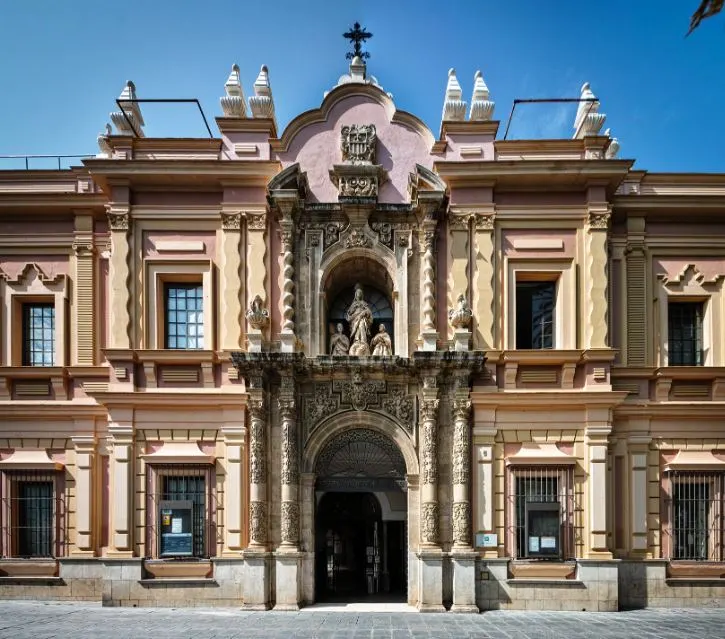
As an art enthusiast, you’re probably going to head to the Museum of Fine Arts in Seville for its fantastic collection.
This world-renowned museum houses some of the finest art displays in Europe, making it a haven for anyone who appreciates the finer things in life.
Museo de Bellas Artes is located in the heart of Seville. The museum is spread over two buildings, the Palacio de Villapanes and the Palacio de Carlos V.
Visitors can explore the museum’s many galleries, which showcase a wide range of art from different periods and cultures.
One of the Museo de Bellas Artes highlights the collection of Spanish art on display. This includes works by some of Spain’s most famous artists, such as Diego Velázquez and Francisco de Goya.
The museum also has an excellent collection of Italian art and several essential works from the Netherlands, France, and England.
However, when it comes to Spanish buildings it is also a masterpiece of architecture in Spain.
This splendid building was a converted convent that has been caringly restored and is now one of t e magnificent structures in Spain.
Dating back to early 1612, the design work of architect Juan de Oviedo boasts his charismatic pillars and archways leading to the most delightful courtyards.
Museo de Bella Artes is one of the best museums in Seville and a must-do activity while you are visiting the city.
Opening times:
The opening times for Museo de Bellas Artes are as follows: Monday to Saturday from 9:00 am to 8:0 pm, and Sundays and public holidays from 10:00 am to 2:00 pm.
Admission to the museum is free for EU visitors and € 1.50 for non-EU visitors.
The best way to get to the museum is by taking the metro to the San Bernardo stop.
15. Hotel Alfonso XIII
The historic Hotel Alfonso XIII was built in the early 20th century (1929) and is a prime example of Sevillian architecture.
It was designed by José Espiau y Muñoz and is named after King Alfonso XIII of Spain, the monarch at the time of its construction.
Hotel Alfonso XIII is a historical interpretation of the local tradition motivated by Arab architecture, showing unmistakable resemblances to other prominent structures constructed during this period.
You’d be right in thinking that the beautifully designed building was fit for royalty, as many Royal dignitaries have stayed here over the years.
It’s a magnificent building that discloses an exciting story of the city’s rich history.
Insider tip:
Go early in the morning or late at night to avoid the crowds and get the best photos. The main entrance is the Puerta del Príncipe (Prince’s Gate) on Calle San Fernando.
16. Torre del Oro
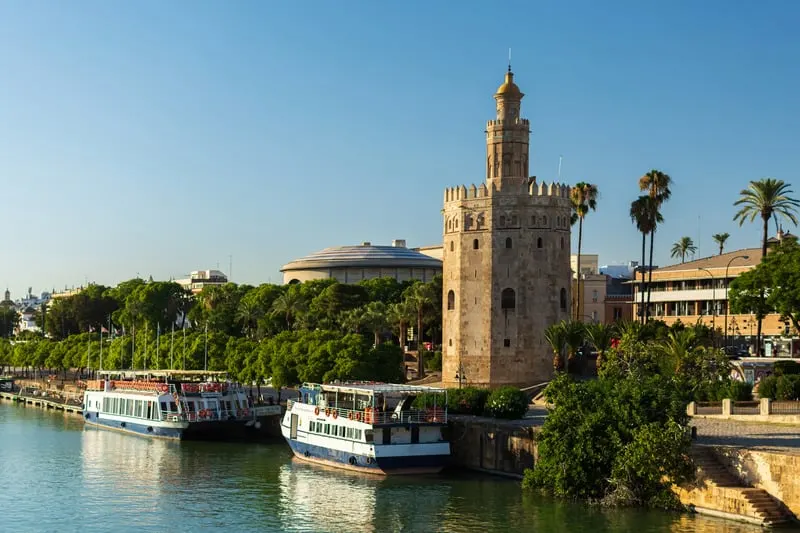
Torre del Oro, or “Tower of Gold,” is one of Seville’s most recognizable landmarks. Located on the bank of the Guadalquivir River, this 12th-century Moorish watchtower was once part of the city’s defensive wall.
These days, it’s a favored spot for photographs with wonderful views of the river and surrounding area.
No one is certain why the Torre del Oro got its ‘Golden Tower’ reputation and name. One rumor suggested that the tower was used to store precious metals and treasures from the Indies.
Yet, in 2005, experts revealed that the structure was covered with a mortar of lime and straw, creating a slight golden reflection.
The tower was built by the Almohads, a Berber Muslim dynasty that ruled over much of southern Spain in the 12th and 13th centuries.
After the Christians reconquered Seville in 1248, they added a golden orb and cross to the top of the tower as a symbol of victory.
These days, the tower is open to the public and houses a small museum with exhibits on its history and construction.
There’s also a panoramic deck on the top level, where you can get sweeping views of the river and city.
Opening times:
Monday – Friday from 9:30 am to 6:45 pm and on weekends from 10:30 am to 6:45 pm. Admission is €3 for adults and €1 for children.
17. Palace of San Telmo
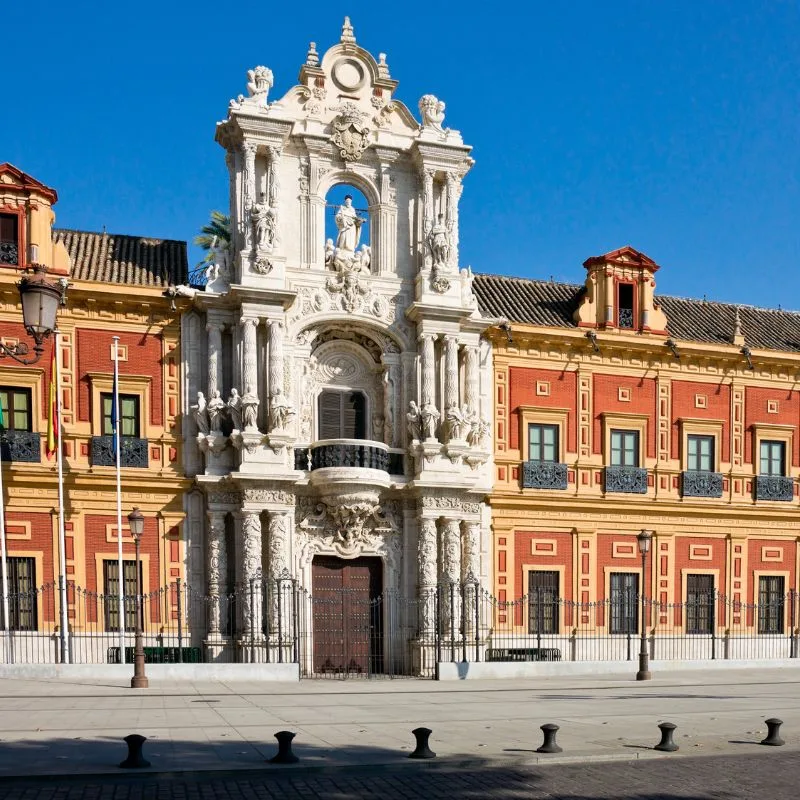
The Palace of San Telmo is one of the most awe-inspiring buildings in Seville. It’s a multi-colored masterpiece that stretches to fill a whole block.
Facing the Avenida de Roma are stone walled gardens extending to the Paseo de las Delicias.
In the 17 Century, at its pinnacle, the pooled gardens were huge, rivaling the Palace of Versailles in France.
Overlooking Avenida de Roma and the Jardines del Cristina is one of the palaces’ principal elements; the luxuriant stone Churrigueresque doorway.
Encircling the columns are female metaphoric figures symbolizing the arts and sciences. There’s al o a statue of San Telmo carrying a vessel and sea mapping charts.
Palacio San Telmo’s construction overlapped three generations and took 70 years to complete.
Named after Saint Elmo, the familiar saint of seafarers, it was built as a marine training academy.
The institute eventually evolved into a royal palace when in 1849, it became the abode of the Dukes of Montpensier.
Although today its a government building, the palace is a testimony to Seville architecture’s influential and celebrated achievements.
Opening times:
The Palace is open Tuesday-Sunday from 04:00 pm – 08:00 pm. Another excellent example of free things to do in Seville.
18. Centro Cerámica Triana
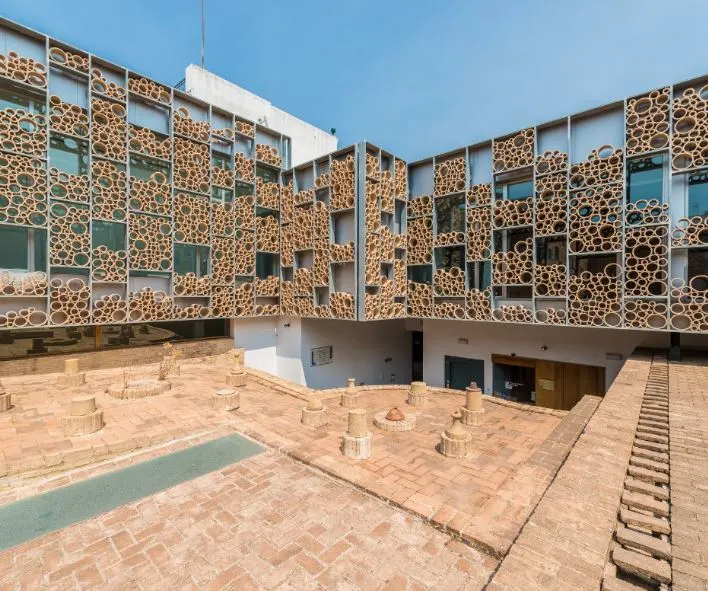
World-renowned architect Santiago Calatrava designed this interesting building. The Centro Cerámica Triana is now home to a museum, library, and auditorium, making it the perfect spot to learn about the city’s rich history and culture.
While at the museum, you’ll be reminded that Triana was home to Seville’s famous tile workshops and potteries in its heyday.
Virtually any tile you notice in Seville’s churches, hotels, bars, and private homes will have been made here in Triana.
The industry stems from the Roman period, using clay from La Cartuja for its structures.
With its soaring ceilings and stunning stained glass windows, the building’s interior is just as spectacular as the outside.
The museum houses an impressive ceramics collection, which will delight any history enthusiasts.
Opening times:
El Centro Cerámica Triana is open Monday-Saturday from 10:00 am- 05:30 pm and Sunday from 10:00 am-03:00 pm.
Admission is free for all visitors, so there’s no excuse not to check out this fantastic building!
19. Hospital de los Venerables
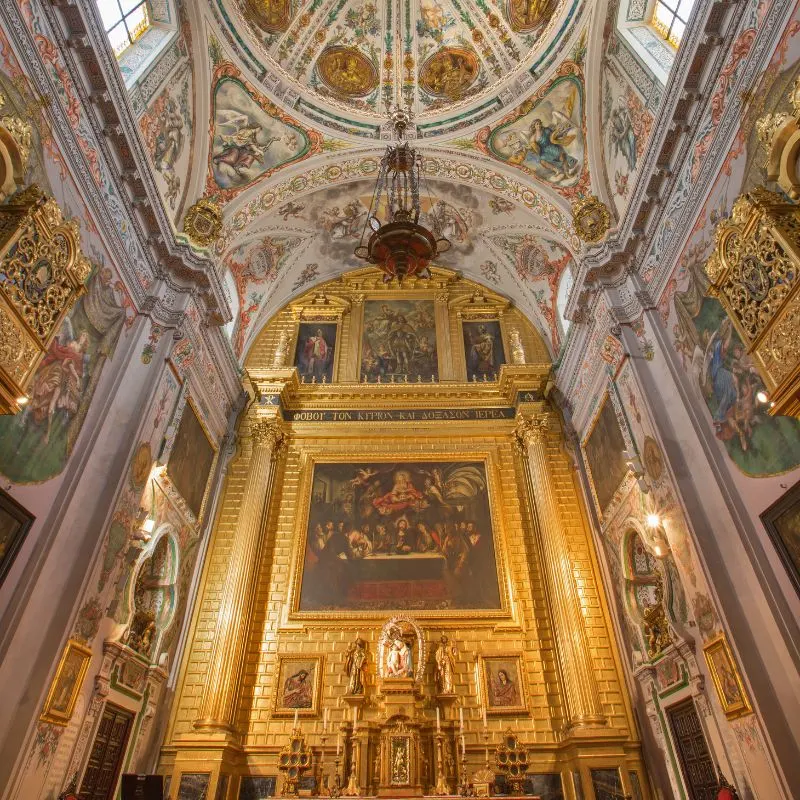
It was built in the 17th century as a hospital to care for the elderly, but it is a beautiful building.
Though not the largest of such buildings, its ornamentation is believed to be among Spain’s most comprehensive and intricate.
The theme of the design revolves around the priesthood and the recognition and honor due to them.
The hospital consists of chambers and edifices positioned on two floors around the notable recessed central courtyard.
The exterior of the building is decorated with statues of Roman emperors and saints and has a beautiful baroque facade. The hospital is open to the public and is definitely worth a visit.
Opening times:
March to June: 10 am to 8 pm. July and August: 10 am to 2 pm and 5:30 pm to 9 pm. September to November: 10 am to 8 pm.
Insider tip:
Make sure to visit the chapel, one of the most exquisite parts of the hospital.
20. Plaza del Cabildo
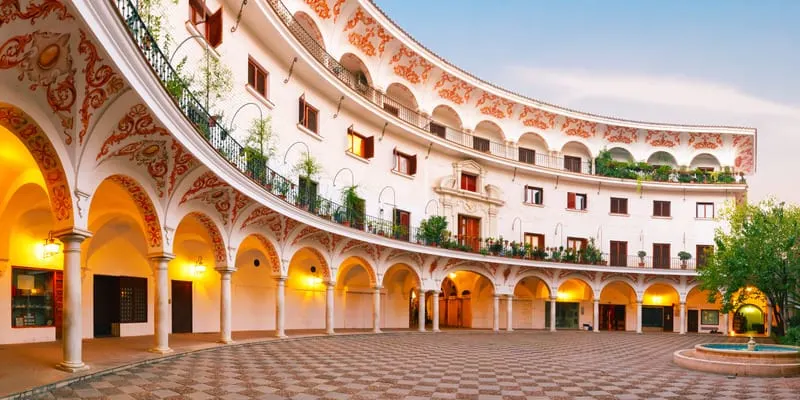
This is one of the most popular squares in Seville and is a great place to people watch. A famous market is held under the historic arches every Sunday, where you can discover stamps, coins, and collectibles.
There are often performers and musicians in the square, reflecting past times. The pretty semicircular structure compliments the unique building surrounding it on its curved side.
There are beautifully painted squares that are a lovely mix of terracotta, grays, and gold.
Other Seville Architecture Places Worth Mentioning
Now that we have described some of the most iconic buildings in Seville, Spain, we must mention other unique places that are hard to ignore. Additional Spanish famous buildings include:
1. Barrio Santa Cruz
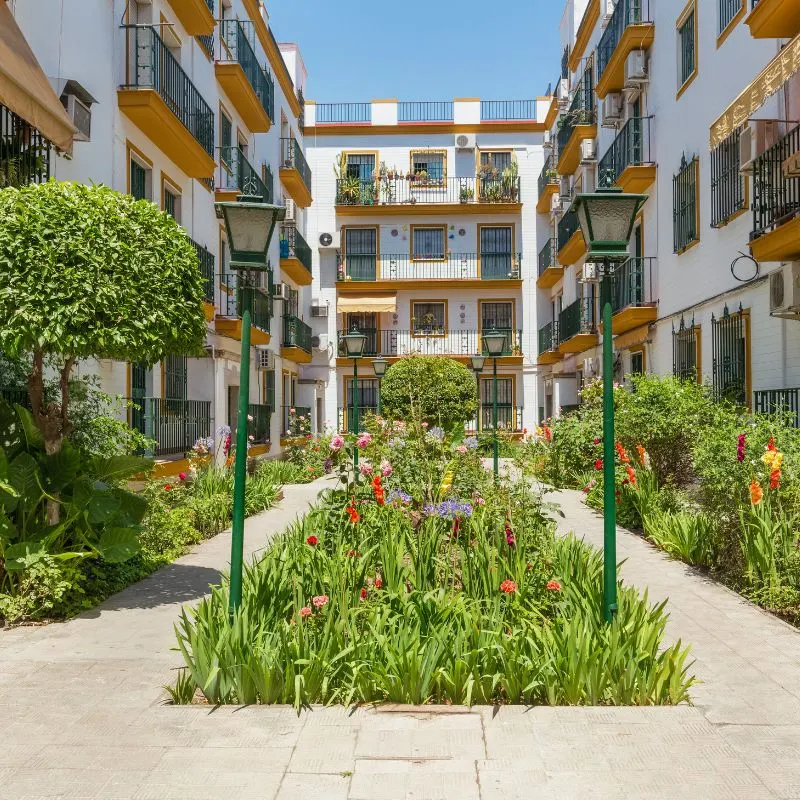
Barrio Santa Cruz is one of the most prevalent areas in Seville, and for a good reason! The Barrio Santa Cruz is full of quaint winding streets and is a great place to explore on foot.
I was in the lovely Barrio of Santa Cruz that Seville’s Jewish habitants were exiled when Ferdina d III seized the city from the Moors in 1248.
With its elegant squares lined with orange trees, it’s hard to believe the area was used as a punishment to confine a nation.
You’ll find plenty of charming cafes and boutique shops to browse, and the area is also home to some of the best tapas restaurants in Seville.
2. The Triana Neighborhood
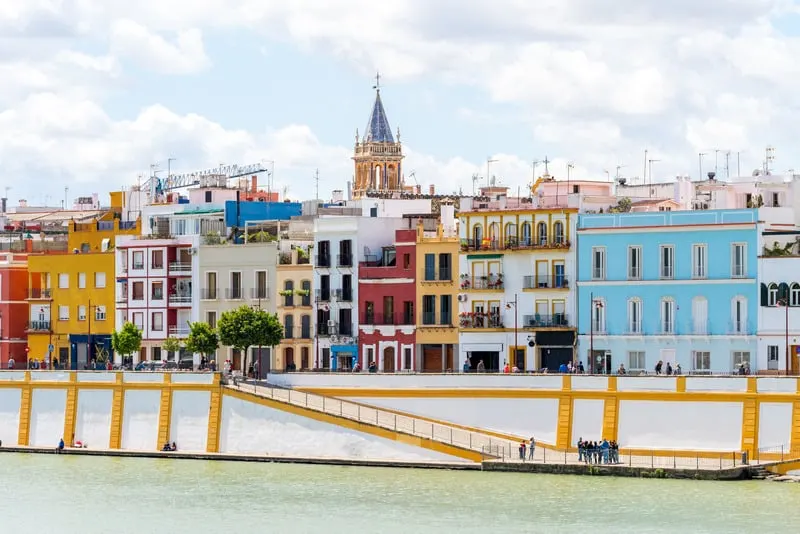
If you want to experience the more authentic side of Seville, then you need to head to the Triana neighborhood.
This is one of the oldest neighborhoods in the city and is known for its ceramics and authentic flamenco music.
Flamenco is an art form that originated with the Roma or gypsy communities in the area, so it’s no surprise that here you’ll find some of the best Flamenco shows in Seville.
Besides famous bridges and ancient castles, there are vibrant streets, such as Betis or Alfarería.
The Triana neighborhood is a Sevilla milestone not to be missed reminding visitors of its old sai or and potter quarter.
3. Church of Lady Mary of La Macarena
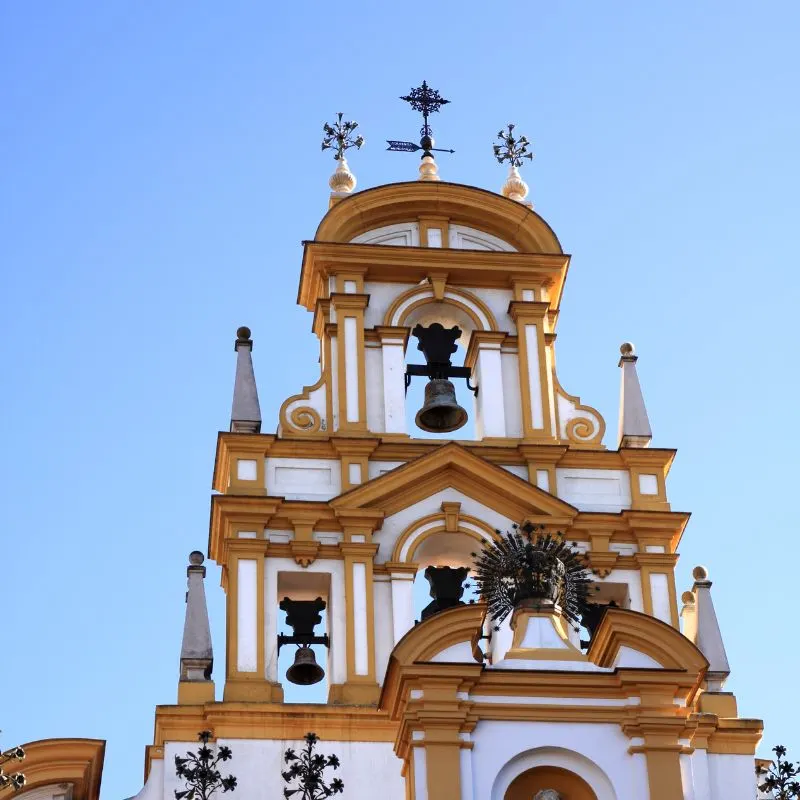
This famous Spanish church is one of Seville’s most important Spanish religious buildings.
It was built in the 1700s and is home to the statue of Our Lady of La Macarena, in which locals boast of its miraculous healing powers.
The ceiling artwork is typical of pretty Spanish architectural styles. The church is open to the public, and the establishment is worth looking at.
Getting Around Seville
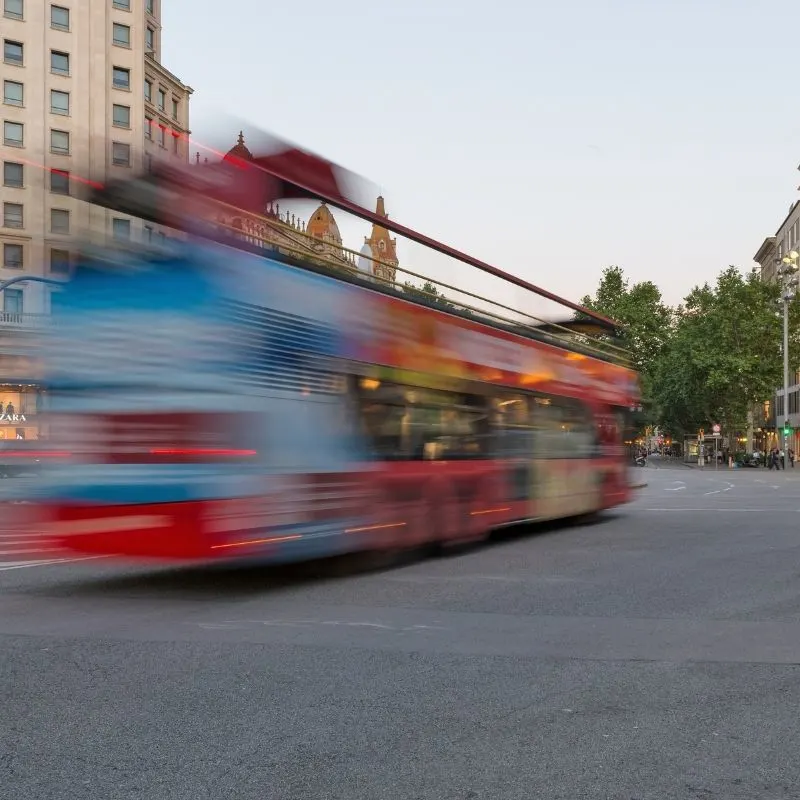
Although Seville is a large city, it’s easy to get around on foot or by public transportation. You’ll appreciate wearing comfortable footwear because the steps soon clock up as there is so much to see!
Don’t forget to obtain a good map with the landmarks marked out so you can encircle the best ones from our list.
If Seville architecture is your main focus of the trip, then Seville’s central neighborhood is an excellent base when determining where to stay in Seville.
All that said, the city has an extensive bus and tram network covering all major attractions.
The Hop-on/Hop-off bus is an excellent option for exploring Seville at your own pace.
The bus has multiple stops around the city, and you can get on and off as often as you like. Tickets can be purchased at any of the city’s tourist information offices.
Another great choice for getting around Seville is by taking a TukTuk. These electric vehicles seat up to six people and are a great way to see the city.
TukTuks can be rented by the hour or day, and you can find them at the most prominent tourist attractions.
With a Tuk Tuk, you often discover places that not everyone gets to know about or drive right past.
If you’re looking for a memorable way to get around Seville, then you can try taking a horse-drawn carriage.
These are available for hire at most of the city’s major squares and offer a great way to see the sights relaxedly. Carriages can be rented by the hour or day, and you can negotiate the price with the driver.
Short FAQ about the Best Seville Architecture
What’s Seville famous for?
Seville is well-known for its famous Spanish buildings, beautiful parks and gardens, and delicious food.
The city is also home to some of the best tapas restaurants in Seville, making it a great place to visit for foodies.
Is Seville, Spain, expensive?
Seville is a great place to visit for budget-minded travelers. The city has plenty of free attractions, and many of the city’s restaurants offer affordable menus.
If you’re looking to save money, we recommend visiting during the off-season and avoiding the city s busiest tourist traps.
Is Seville worth visiting?
Yes, Seville is, without a doubt, worth visiting! The city has plenty to offer, a rich historical and architectural legacy, fascinating culture, and gastronomy.
There are also plenty of great places to stay for your trip to see many famous landmarks in Spain.
With so many unique experiences available in Seville, considering what to do in Spain shouldn’t be a concern.
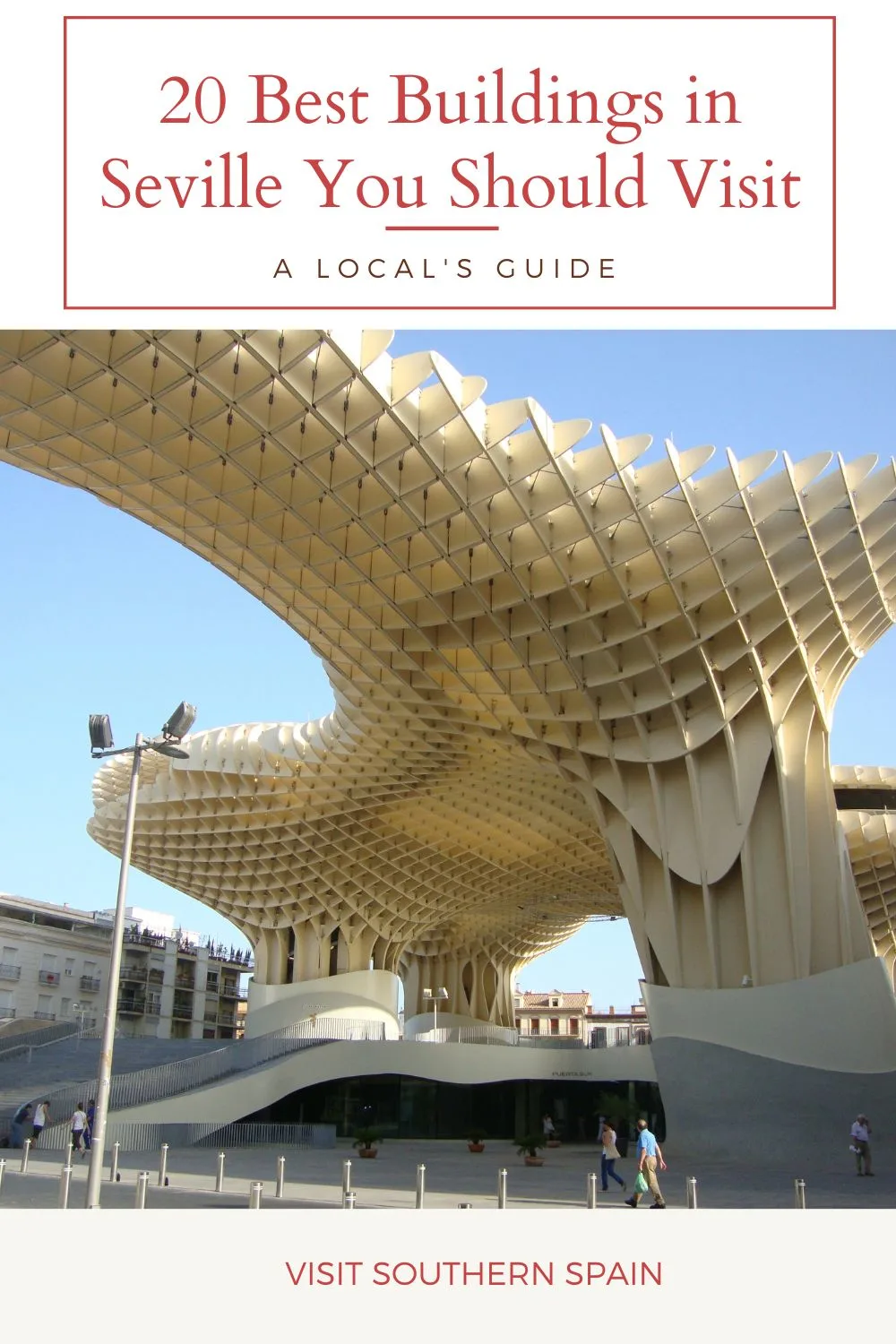


Hola, I’m Paulina! Together with my team, we are passionate about Southern Spain. Here we share all you need to know for great times in Southern Spain with the best places to visit, stay and, of course, the best food to eat.
Let’s dive in and explore Southern Spain’s outdoors, food and culture con pasión!

